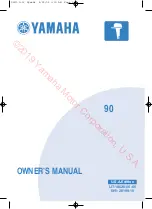SDMA Channels and IDMA Emulation
MPC885 PowerQUICC Family Reference Manual, Rev. 2
19-12
Freescale Semiconductor
19.3.4.1
Function Code Registers—SFCR and DFCR
The user programs an IDMA channel’s source and destination function code registers (SFCR and DFCR)
with separate 3-bit function codes to tag the channel’s source and destination accesses. The function code
registers also determine the byte-ordering convention.
Figure 19-9
shows the register format.
Table 19-8
describes the function code register bit settings.
19.3.4.2
Auto-Buffering and Buffer-Chaining
Buffer-chaining is designed to move large amounts of noncontiguous blocks of data. Even though each
block needs a separate BD, the BDs can be chained together and serviced as a group. Auto-buffering is
used to repeatedly service a BD chain. Note that a chain can range from one BD to the whole BD table in
length.
Setting the CM bit (continuous mode) in a BD’s status-and-control field enables auto-buffering; clearing
the CM bit enables buffer-chaining (normal mode). The CM bit must be explicitly programmed for each
BD.
When auto-buffering, the descriptor’s V bit will not be cleared after CPM processing—the BD remains
valid for immediate transfer as the current BD pointer cycles through the table. When buffer-chaining, the
CPM invalidates the current BD after processing to allow the user (the core) to safely manipulate the
contents of the buffer and modify its BD. Note that the V bit behavior is the only difference between
auto-buffering and buffer-chaining—auto-buffering can be thought of as continuous buffer-chaining. One
use of auto-buffering is for continuous monitoring of an external instrument, such as an A/D converter.
Set the L bit (last) in the status-and-control field to mark the last BD of a chain. When the CPM completes
a chain, it flags IDSR[DONE], triggering a maskable interrupt to the core. The I bit (individual BD
0
2
3
4
5
7
Field
—
BO
AT[1–3]
Addr
DFCR is at offset 0x02. SFCR is at offset 0x03.
Figure 19-9. Function Code Registers—SFCR and DFCR
Table 19-8. SFCR and DFCR Field Descriptions
Bits Name
Description
0–2
—
Reserved. Should be cleared.
3–4
BO
Byte ordering. Set BO to select the required byte ordering for the buffer. If BO is changed on-the-fly,
it takes effect at the beginning of the next frame (Ethernet, HDLC, and transparent) or at the beginning
of the next BD. See
Appendix A, “Byte Ordering
.”
00 Reserved
01 Modified little-endian
1x Big-endian or true little-endian
5–7
AT[1–3]
Address type 1–3. Holds the function code for an IDMA channel memory access. Note AT[0] is driven
high to identify the access as a DMA type. Note that for the last IDMA cycle, the terminal count code
AT[0–3] = 0xF replaces the user-defined function code signaling the end of transfer to the peripheral.
Summary of Contents for PowerQUICC MPC870
Page 98: ...MPC885 PowerQUICC Family Reference Manual Rev 2 I 4 Freescale Semiconductor ...
Page 118: ...MPC885 Overview MPC885 PowerQUICC Family Reference Manual Rev 2 1 20 Freescale Semiconductor ...
Page 158: ...The MPC8xx Core MPC885 PowerQUICC Family Reference Manual Rev 2 3 18 Freescale Semiconductor ...
Page 288: ...MPC885 PowerQUICC Family Reference Manual Rev 2 III 4 Freescale Semiconductor ...
Page 554: ...MPC885 PowerQUICC Family Reference Manual Rev 2 V 6 Freescale Semiconductor ...
Page 1090: ...UTOPIA Interface MPC885 PowerQUICC Family Reference Manual Rev 2 43 8 Freescale Semiconductor ...
Page 1312: ...Byte Ordering MPC885 PowerQUICC Family Reference Manual Rev 2 A 8 Freescale Semiconductor ...
Page 1336: ...MPC885 PowerQUICC Family Reference Manual Rev 2 D 16 Freescale Semiconductor ...
Page 1358: ...MPC885 PowerQUICC Family Reference Manual Rev 2 D 38 Freescale Semiconductor ...
Page 1370: ...MPC880 MPC885 PowerQUICC Family Reference Manual Rev 2 E 4 Freescale Semiconductor ...
Page 1386: ...Revision History MPC885 PowerQUICC Family Reference Manual Rev 2 I 2 Freescale Semiconductor ...

















